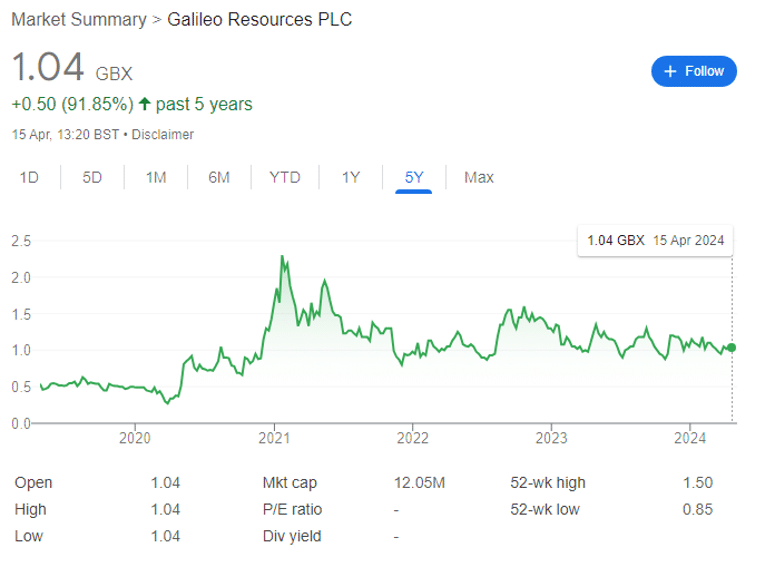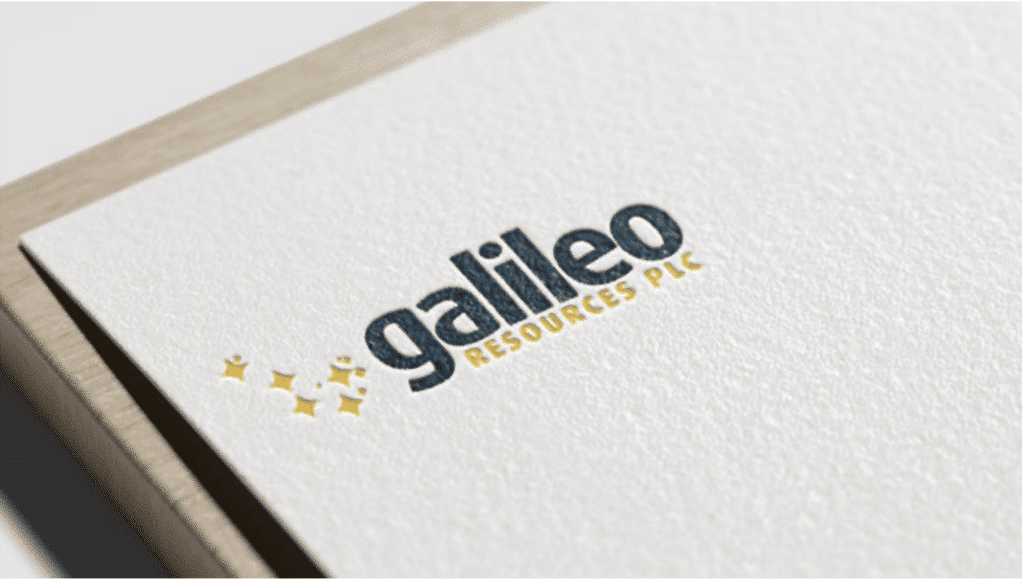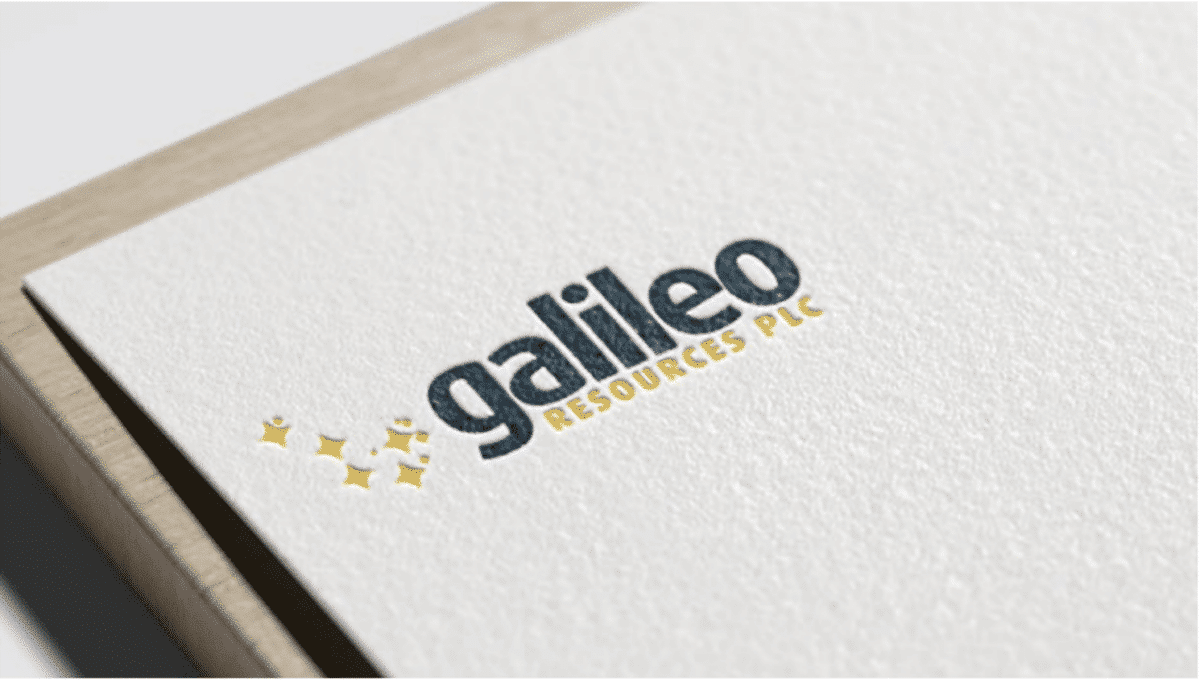Galileo Resources is advancing multi-commodity properties across a diverse portfolio, including promising copper assets in Zambia.
Welcome to this week’s EDIT, where I spend the day doing a deep dive into a single small cap stock — with the aim of creating a condensed investment case within a single article. This week, it’s Galileo Resources, which has held up remarkably well through this period of weak junior resource sentiment.
Before we get started, the usual caveats:
- This is not financial advice. Do your own research and make your own decisions.
- There are some important first steps to consider before investing in AIM shares, or in mining shares. Generically, these centre around developing financial resilience and diversification.
- While Galileo Resources (LON: GLR) appears to be a solid opportunity at this price level, it is a small cap. This means higher risk than those associated with larger companies, but with correspondingly larger potential upside.
I am aware that these caveats might be feeling a little stale, but it’s important — especially for newer investors — to continually appraise their risk appetites.
Galileo Resources shares have nearly doubled over the past five years, including the pandemic-era minicrash and subsequent pandemic-based rocket to 2.3p in January 2021. The stock has bounced around over the past few years, but the 1p level remains a baseline of sorts.

Let’s dive in.
Galileo Resources: Investing Strategy
Galileo sets out its stall very clearly: the model is to acquire assets with large data bases generated by major companies and abandoned for strategic, corporate, technical, and other reasons which ‘do not necessarily reflect the potential value of the projects.’
This is an eminently sensible policy, especially in the current market where getting hold of the capital to develop assets without any initial data is becoming ever harder. Having taken a look at the asset portfolio, a common theme is that Galileo acquires assets in jurisdictions considered investor unfriendly, and then waits for the political tide to turn — as it has in Zambia.
Galileo now holds interests to varying degrees in the following assets:
- Luansobe Copper Project, Zambia
- Shinganda Copper & Gold Project, Zambia
- Western Foreland Copper Project, Zambia
- Kashitu Zinc Project, Zambia
- Kamativi Lithium and Bulawayo Gold Projects, Zimbabwe
- Kalahari Copper Belt Project, Botswana
- Ferber Project, Nevada (US)
- Glenover Project, South Africa
Unlike other EDITs, I am not going to go deeply into the investment cases for these metals — the copper supply gap was recently covered in depth for African Pioneer, Gold is at a record price and some of the bullish factors are in Greatland Gold’s coverage, and I have also covered where lithium will go next here.
It’s a good idea to read them all as it helps to understand how well Galileo is positioned.
I would note on gold that Citi’s prediction of $3,000 may well come true. The weaponisation of US dollars has seen China sell US treasuries and buy gold instead, alongside record buying at central banks across the world. And the US debt/deficit problem isn’t going away. Slowly, this may be eliminating one safe haven, which is having the artificial effect of inflating gold as investors who once split their cash between the US dollar and gold now opt only for the latter.
However, as gold theories seem to be changing to fit the narrative (high rates should have seen the metal fall), take predictions with more than a pinch of salt.
Galileo Resources asset base

Going through every detail would come close to a doctoral dissertation in terms of length, so I have tried to bring together the most salient points. As a primer, my opinion remains that copper is the red hot commodity of 2024 — if in doubt, just Google ‘copper price.’
After Zambian government reforms, it’s also my view that the country is the ‘place to be.’ Operators are scrambling to get hold of prospective licences now that the rules have changed — and Galileo pre-empted this and got there first.
For context, Zambia now charges:
- Flat corporation tax at 30%.
- Mineral royalty up to 10% but this can be deducted from corporation tax.
- Export duty for precious metals and some critical minerals at 15%, though this usually does not apply to copper.
- Withholding tax at 15%, but are dividends not included within this anymore.
Of course, you also benefit from cheaper labour and opex costs. And in copper specifically, imports on equipment is duty free, miners can deduct 100% of capex in the first year instead of having to spread it out over its lifespan (the UK did something similar to expensing recently), there is zero VAT on copper exports, you can claim VAT input on tax paid for capex, you can carry forward losses for an entire decade, and you can claim input tax for pre-production expenditure for five years…
All of which sends the strong message: Zambia will tax you fairly, encourage you to get started, and wants your investment. President Hakainde Hichilema has set a target to expand copper production from 800,000 tonnes per year to 3 million tons by 2030 — and Jubilee’s expansion, Anglo’s JV deal with ARC, the new railway being built, the major discovery, the major Kobold discovery, the fight for assets — all of it points to a red hot few years in the country.
With that being said, I have split the assets into Zambia and non-Zambia — and have covered key recent news as succinctly as possible.
Zambia assets
Luansobe — in which Galileo owns a 75% interest — is situated 15km from Mufulira Mine in the Zambian Copperbelt which produced over 9Mt of copper. It forms part of the north-western limb of the northwest – southeast trending Mufulira syncline, and is arguably a strike continuation of Mufulira, with copper mineralisation hosted in the same stratigraphic horizons.
On 9 February 2023, Galileo announced a new Inferred Mineral Resource for the project estimated by external consultants Addison Mining Services:
- Approximately 5.8 million tonnes gross at 1% total Cu above a cut-off grade of 0.25% total Cu for 56,000 tonnes of contained Cu, potentially amenable to open pit mining.
- Approximately 6.3 million tonnes gross at 1.5% total Cu above a cut-off grade of 1% total Cu for 97,000 tonnes of contained Cu, potentially amenable to underground mining.
Since then, work has continued towards development of a potential open pit mine plan.
Shinganda — covers part of a major 10 kilometre structural trend with two previously developed small-scale open pit copper-gold mines. Limited historic drilling on the property is reported to have intersected 1.07% Cu over a true width of 28.3m at shallow depth within supergene copper oxides. Drilling on the structure within the Shinganda property further to the west by Vale recorded a 2m interval @ 3.93% Cu, 1.72g/t Au.
Limited historical drilling and sampling at Shinganda returned best intercepts of up to 50.3m @ 1.54% Cu from 21m downhole depth in drill hole SHDD002, and a peak of 33.90g/t Au was returned from a composite grab sample in an exploration pit.
The current drilling program remains on track, with seven holes completed so far, totaling 890m in advance. The latest hole, SHDD017, has revealed extensive alteration and brecciation with associated copper mineralization within the Shinganda Fault Splay system.
This hole, designed to test the IOCG deposit potential, encountered a wide zone of hydrothermal alteration and mineralisation over a 264.5m interval. Mineralisation occurs in clusters and disseminations associated with brecciation and veining, confirmed by pXRF analysis.
Follow-up drilling is designed to explore the mineralised zone and test iron alteration clusters and IP targets identified by previous studies. Additionally, other short holes drilled to test outcropping occurrences intersected shallow oxide mineralization with anomalous copper, with samples being sent for laboratory assay.
Chairman and CEO Colin Bird enthused this was a
‘particularly impressive hole….the nature of the host environment is not typical for traditional Copperbelt mineralisation which leads us to believe that this could be a totally different style of mineralisation. There is good district evidence for IOCG-type mineralisation and we are targeting drilling with this model in mind. The next hole will be sited 100m away to test for mineral style repetition and continuity.’
Kashitu — a new four-year small-scale exploration licence was issued in February 2022 for this project. However, it remains essentially in limbo. While Galileo has made contact with various interested parties including potential providers of third-party processing capacity for the on-site open pittable high-grade willemite, the removal of access to parts of the Kashitu licence for small-scale and artisanal miners could have a profound impact on livelihoods in the area.
Translated, this means while the plan is to continue to identify targets for further drilling, the most important factor is to get the local population on board with a business plan.
NW Zambia Joint Venture — in September 2023, Galileo entered into a JV with Cooperlemon Consultancy to explore for copper at exploration license 28001-HQ-LEL in Northwest Zambia.
The licence covers some 52,000 hectares and runs along the Angolan-Zambian border. It’s closely associated with the perceived Western Foreland geological district boundary that potentially hosts Kamoa – Kakula deposits in Northwest Zambia.
Under the joint venture agreement Galileo agreed it will earn a 65% interest by making an immediate cash payment of US$230,000 to Cooperlemon, and funding exploration expenditure of at least $750,000 over an initial — Phase 1 — eighteen-month period on the Licence. Exploration activities will include physical tasks such as mapping, soil geochemistry, geophysics, and drilling, as well as desktop studies, laboratory analysis, and data interpretation.
If Phase 1 exploration results demonstrate the continuity of mineralisation at grades suggesting potential for future development of a Mineral Resource of at least 500,000 tonnes of contained copper, with an internal rate of return of at least 25% and a payback period not exceeding 42 months, a second two-year — Phase 2 — exploration period will follow.
Ex-Zambia assets
Kalahari Copperbelt — Galileo recently announced the discovery of three promising copper targets following a Terraleach soil survey on its PL253/2018 license.
These targets align with known copper-hosting structures and are near existing copper mineralisation on neighbouring licenses. The findings are supported by public data on nearby deposits and Galileo’s successful use of metal-ion geochemistry.
By overlaying Galileo and Cobre soil anomaly maps, the targets appear contiguous and associated with similar geological features. The company is now considering its strategy for further exploration leading to drilling of these promising targets, as the combined strike length exceeds 6km.
Bird noted he is very pleased that our immediate neighbour Cobre Limited has been selected for the 2024 “BHP Xplor Program”. This is indeed a commendation reflecting the Company’s efforts and the quality of its Copper Belt licences. Importantly, current published information quite clearly shows our new targets to be contiguous with known targets and mineralisation on these highly prospective licences.’
Shortly afterwards, the company identified two additional targets on licenses PL039/2018 and PL040/2018 in the southeastern basin margin. Previous scout drilling revealed the correct lithological sequence associated with mineralisation, prompting further soil sampling — which led to the discovery of these new targets.
The new targets, situated in the ‘Galileo Fold,’ share a geological setting similar to areas drilled by Khoemacau and Arc Minerals, adjacent to the Mowana Fold axis. For context, Khoemacau reported drill intercepts at Mowana including 4.3m @ 1.65% Cu and 6.1m @ 2.56% Cu, while Arc’s scout holes yielded intervals up to 3.65% Cu.
Independent assessment suggests that the Galileo Fold shares the prospectivity of the Mowana Fold, with PL039/2018 exhibiting anomalous soil results associated with the plunge nose of the Galileo Fold structure, while PL040/2018 has three geochemical targets, with the southern target extending over 2.8km.
Bird advises these ‘new targets are very encouraging particularly when you consider that the copper values in soils on PL39/2018 define an area independently assessed to be directly analogous to the Khoemacau/Arc Mowana Fold prospect…the scale of our discoveries should also not be overlooked for example, the southern target on PL40/2018 is the same size as Khoemacau’s Zone 5 target. In the coming months we will undertake further work to pin down drilling targets in this exciting area.’
It’s worth noting that Galileo sold some nearby licences to Sandfire in 2021, which have subsequently seen significant work — and there is therefore a natural buyer/JV partner for additional work.
Zimbabwe assets — Galileo recently announced it has fulfilled conditions required to acquire an additional 51% interest in BC Ventures, and now owns 80% of the business, which in turn owns the Kamativi Lithium Project in Southwest Zimbabwe and two gold licenses, known as the Bulawayo Gold Project, situated close to Bulawayo, through its wholly owned Zimbabwe subsidiary, Sinamatella Investments.
It’s always fun untangling subsidiaries. The company has recently applied to Zimbabwe authorities for a three-year renewal of all three exploration licenses until March 2027.
The Kamativi Lithium Project comprises EPO 1782, covering 520 square kilometres, and which lies on the Kamativi Belt directly adjacent to, and along strike from, the historic Kamativi tin- tantalum mine which operated from 1936 to 1994.
The Kamativi Mine produced 37,000 tonnes of tin and 3,000 tonnes of tantalum ore from pegmatites, and in 2018 Chimata Gold Corp announced a new JORC compliant Indicated Mineral Resource of 26Mt @ 0.58% Li2O within the Kamativi mine tailings, confirming that the mine contained significant quantities of lithium. Moreover, this mine has recently been brought back into production for hard rock lithium.
The Sinamatella licence area encloses extensions and splays of the Kamativi Tin Mine host unit, including mapped pegmatites, and it has been anecdotally reported that there are old tin-fluorite workings within the Sinamatella property. The licence area also contains a large extent of the pre-Cambrian Malaputese Formation which is considered to be strongly prospective for VMS hosted copper, surrounding the old Gwaii River Copper Mine and including numerous other copper prospects and occurrences.
Little exploration has been carried out on this licence area over the past few decades, but there is very good historical data available to advance exploration for lithium prospects — and it’s in a very prospective area.
In a further recent update on Kamitivi, assays have been received from ALS Chemex for its 10-hole Phase 1 angled drilling programme — which took place over an area of about 1km x 0.5km, and shows extensive lithium enhancement focussed on cross-cutting pegmatites and within mica-schist host rock.
Hole KSDD001 — confirmed by assays at ALS Global Laboratories — included a zone of 4m @ 1.03% Li2O from 35m depth in a discordant pegmatite within a wide 63.94m zone assaying 0.26% Li2O across both pegmatites and mica-schist host rock. Thin section and XRD mineralogical examination also confirmed the presence of spodumene mineralisation in the KSDD001 intercept — though further work will be required to identify the nature of more widespread lithium mineralisation within the host rock.
Further exploration will focus on cross-cutting pegmatite/aplite dykes, as well as the source of the widespread lithium occurrences both within the current Target 1 and at four other identified target zones on the property.
Bird notes that ‘an unusual feature of this discovery is the spread of highly anomalous lithium through the mica schist host rock as opposed to being solely contained within the pegmatite. We have no doubt that discordant pegmatites are the drivers to lithium content and our mapping programmes have located more discordant pegmatites than previously recognised…we plan to undertake further drilling for lithium and tin based on this Phase 1 drilling outcome and results of the mapping work.’
It’s also worth noting that Galileo plans to explore targets close to the historic Gwaii Copper Mine in the southern part of the licence, where new soil anomalies have been identified. These will be followed up at the same time as the lithium programme.
In Bulawayo, the stated aim is to explore for resources to support the development of a large scale mine. The licences adjoin and enclose a number of small-scale gold mines on pre-existing mining permits which provides the opportunity to integrate the production from these operations which have a total historic production reported as more than 1Moz Au.
Follow-up soil sampling of a number of geophysical targets delineated by Galileo’s previously reported ground geophysical surveys have defined a number of new targets marginal to the Queen’s Gold Mine area (not part of Galileo’s licence area), where historical gold production >44,000 ounces was reported up to 1984, when reliable record keeping ceased.
A total of 2,455 soil samples were sent for laboratory analysis last year, with results peaking at 2.1g/t Au. An anomalous 5 square kilometre area with gold-in-soil values up to 680ppb Au has been highlighted over a number of structures delineated by the aeromagnetic survey to the southeast of the Queen’s Mine area, with further anomalous zones indicated along-strike from the Queen’s Mine area mineralisation within consistent and prospective greenstone lithology.
The bottom line
Galileo Resources has built a significant asset base, much of it within Zambia, and much focused on copper — which is potentially about to go stratospheric. With multiple plans for assays, potential mines, joint ventures, Copperlemon et al, it’s well placed to benefit from a perfect storm.
This article has been prepared for information purposes only by Charles Archer. It does not constitute advice, and no party accepts any liability for either accuracy or for investing decisions made using the information provided.
Further, it is not intended for distribution to, or use by, any person in any country or jurisdiction where such distribution or use would be contrary to local law or regulation.

